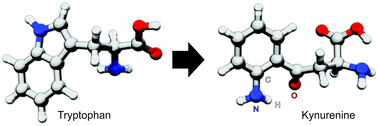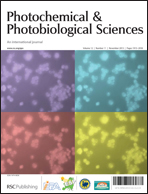Protein oxidation: identification and utilisation of molecular markers to differentiate singlet oxygen and hydroxyl radical-mediated oxidative pathways
Abstract
The effect of reactive oxidation species (ROS) on tryptophan or tyrosine was investigated by qualitatively determining the major detectable oxidation products generated by hydroxyl radicals, produced by the Fenton process, or singlet oxygen, generated by exposure to green light in the presence of Rose Bengal, on these photosensitive amino acids in synthetic pentapeptides. Based on mass spectrometric analysis it would appear that the hydroxyl radical favours a pathway leading to the formation of tryptophandione-based products from tryptophan. In contrast singlet oxygen attack appears to favour the formation of kynurenine-type products from tryptophan. Specific oxidative products observed proteomically are therefore potentially able to discriminate between predominant ROS-mediated pathways. To validate these findings, a keratin-enriched extract was exposed to UVB light under aqueous conditions. The observation of the conversion of tryptophan to hydroxytryptophan in marker peptides, and the absence of singlet-oxygen specific modifications, suggested that under these conditions oxidative degradation occurred primarily via hydroxyl radical attack. These observations provide the first direct proteomic evidence of the dominant photodegradation pathways in wet wool.


 Please wait while we load your content...
Please wait while we load your content...